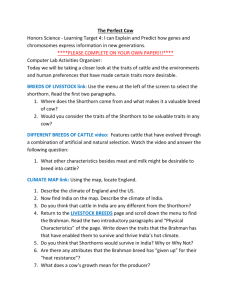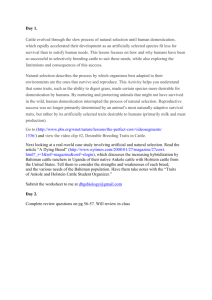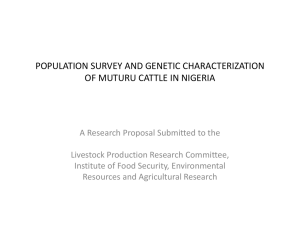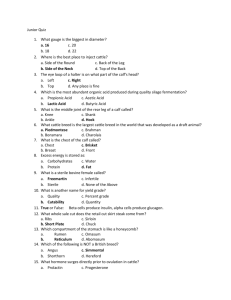The Perfect Cow(student copy)
advertisement
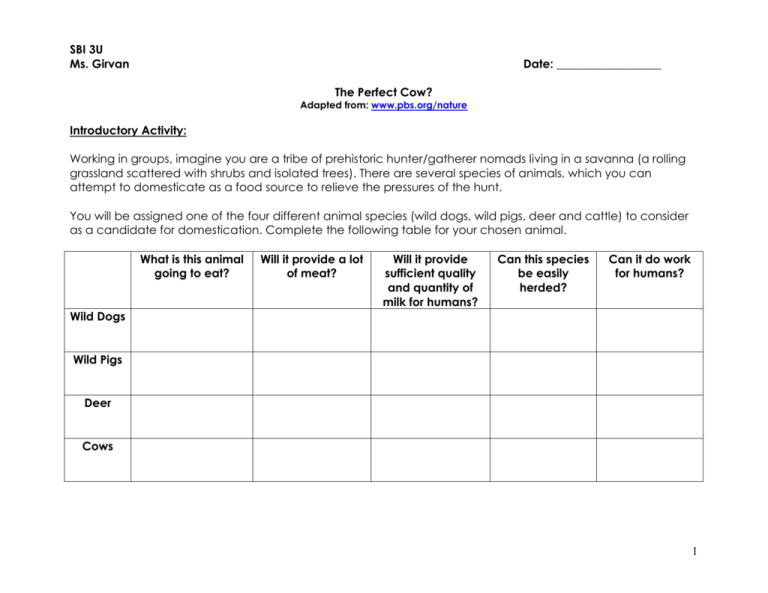
SBI 3U Ms. Girvan Date: __________________ The Perfect Cow? Adapted from: www.pbs.org/nature Introductory Activity: Working in groups, imagine you are a tribe of prehistoric hunter/gatherer nomads living in a savanna (a rolling grassland scattered with shrubs and isolated trees). There are several species of animals, which you can attempt to domesticate as a food source to relieve the pressures of the hunt. You will be assigned one of the four different animal species (wild dogs, wild pigs, deer and cattle) to consider as a candidate for domestication. Complete the following table for your chosen animal. What is this animal going to eat? Will it provide a lot of meat? Will it provide sufficient quality and quantity of milk for humans? Can this species be easily herded? Can it do work for humans? Wild Dogs Wild Pigs Deer Cows 1 Activity #1 1. Watch the video clip – “A Cow’s Digestive System”. While watching the video clip note ways in which a cow’s digestive system differs from your own. 2. How do you think domestication affects the process of natural selection in cows? 3. What is now replacing natural selection as the determinant of reproductive success for any given domesticated cow? 2 Activity #2 1. What the video clip – “Desirable Breeding Traits in Cattle”. While watching the video clip write down the traits that human seek: a. in breeding a good beef cow b. in breeding a good dairy 2. Go to the “Breeds of Livestock” web site. (http://www.ansi.okstate.edu/breeds/cattle/) a. Use the menu on the left of the screen to select the Shorthorn. b. Read the first two paragraphs. c. Where does the Shorthorn come from? d. What makes it a valuable breed of cow? 3 Activity #3 1. Watch the video clip – “Different Breeds of Cattle”. While watching the video clip answer the following question: a. What other characteristics besides meat and milk volume might be desirable to breed into cattle? 2. Check out the world climate map - http://www.arch.hku.hk/~cmhui/teach/climzone.jpg a. Locate England – describe the climate in England b. Locate India – describe the climate in India c. Do you think cattle in India is any different from Shorthorn cattle? 3. Return to the “Breeds of Livestock” web site. (http://www.ansi.okstate.edu/breeds/cattle/) a. Use the menu on the left side of the screen to select Brahman. b. Working in your groups, read the first two paragraphs and the “Physical Characteristics” section of the web page. c. Write down the traits of the Brahman that have enabled it to survive and thrive in India’s hot climate. 4 Activity #4 Go to the “Genetic Engineering Website” (http://regentsprep.org/Regents/biology/units/heredity/engineering.cfm) 1. Read the “Selective Breeding” section. a. Define “hybridization”. There are approximately 1.3 billion cattle in the world today - approximately twice the number that existed 40 years ago. Can you think of any another species that has doubled its population over the same period? What do you think the link might be? 2. As a class we will review the science of heredity, which supports artificial selection, by playing the Punnett Square Interactive: http://www2.edc.org/weblabs/Punnett/Punnettsquares.html Answer the following questions: a. In the interactive’s first exercise, what is the likelihood that the two chickens will produce brown chicks? b. Define what a “carrier” is in terms of traits. c. Define a “dihybrid” cross-breeding. 5 3. In your groups, simulate a simplified dihybrid cross of meaty Shorthorn cattle and heat-resistant Brahman cattle. Complete the following crosses: 1st Generation: Cross a Shorthorn cattle with the genotype MMhh (where “M is the dominant allele for meatiness) with a Brahman cattle mmHH (where “H” is the dominant allele for heat resistance). 2nd Generation: Both the parents from the first generation have gone to the slaughterhouse, so you must breed your 1st Generation cattle. Do you think the 2nd generation will be more, less or equally as likely to carry dominant traits for meatiness and heat resistance than the 1st generation? 6 3rd Generation: Which of your 2nd generation genotypes would you breed to create a 3rd generation of cattle with the greatest likelihood of being both meaty and heat-resistant? Show the cross. a. What is the likelihood of your 3rd generation carrying dominant traits for both meatiness and heat-resistance? b. How might they breed further generations in which these qualities would be guaranteed? The recessive gene for heat resistance (h) – one that we have been actively breeding out of the herd – has just been discovered to provide a natural resistance to a certain tropical disease. c. What percentage of your 3rd generation can be expected to lack resistance to this disease? d. What percentage would lack resistance if it were the recessive gene for meatiness that provided resitance? 7 Homework: Examine a real-world case study involving artificial and natural selection. 1. Read the article “A Dying Breed” (http://www.nytimes.com/2008/01/27/magazine/27cowt.html?ref=world), which discusses the increasing hybridization by Bahiman cattle ranchers in Uganda of their native Ankole cattle with Holstein cattle from the United States. 2. Consider the various strengths and weaknesses of each breed, and the various needs of the Bahiman population. Complete the “Traits of Ankole and Holstein Cattle” handout. 8
